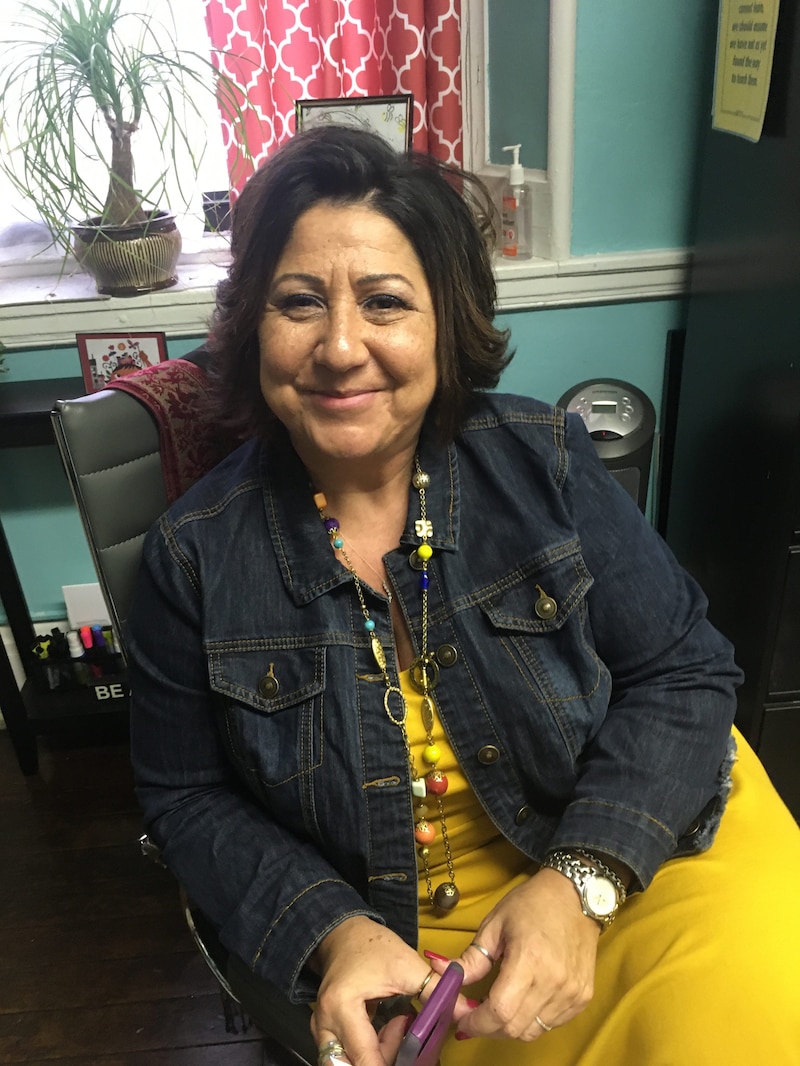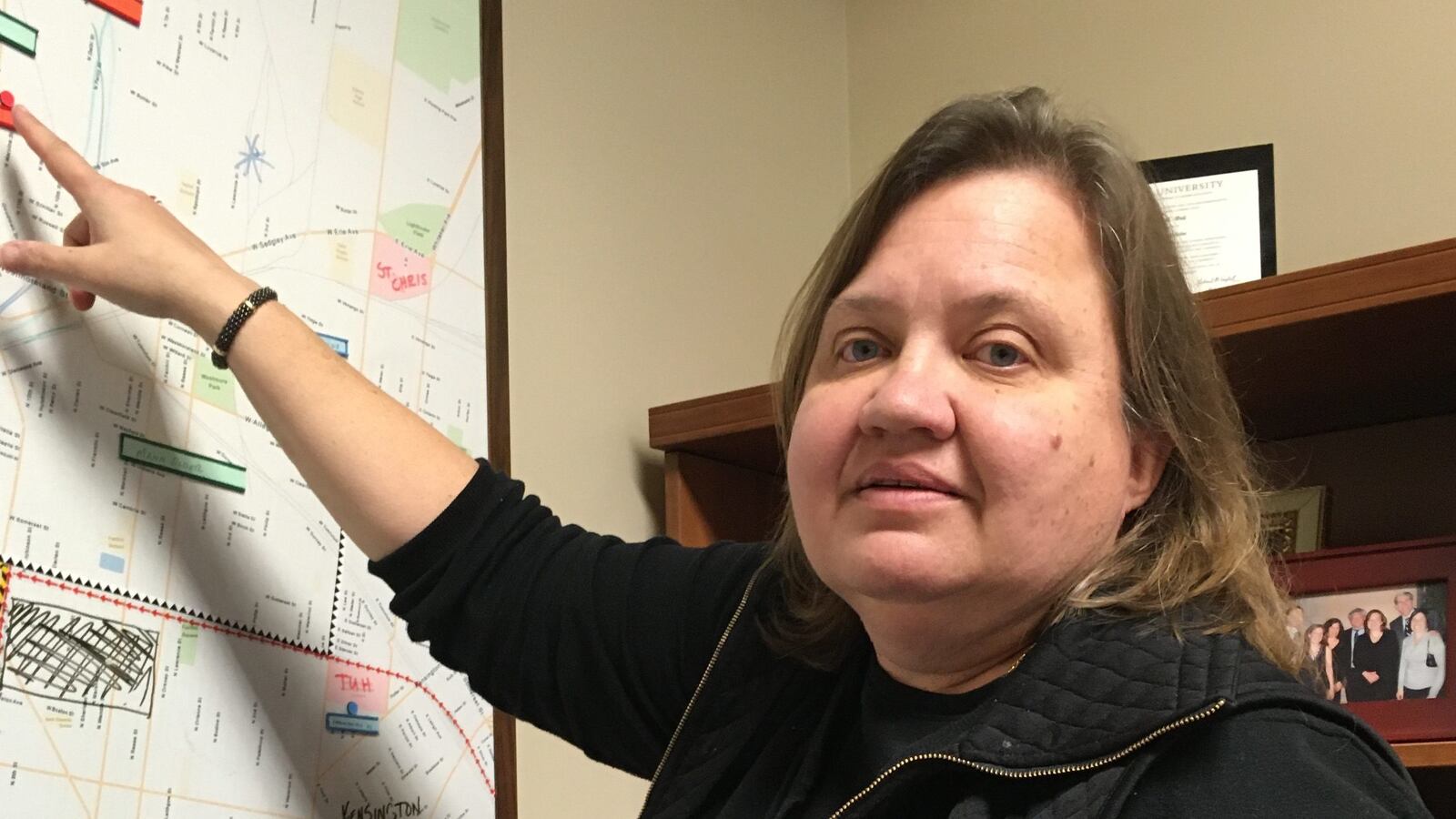This article was originally published in The Notebook. In August 2020, The Notebook became Chalkbeat Philadelphia.
In a March 2019 report, Philadelphia-based Research for Action cited several examples of successful strides toward trauma-informed education. These included the Pottstown School District and the Mastery Schools charter network.
On a Monday afternoon as dusk is settling, about 50 of the newer teachers in the Pottstown School District sit in the high school cafeteria getting their introduction to trauma-informed education.
Laurie Kolka, the district’s director of curriculum and educational programs, and two parent trainers, Kizmect Meade and Mercedez Jackson, go over topics such as brain biology and its effect on learning, and how trauma can affect classroom behaviors such as aggression, defiance, and withdrawal.
Asked for takeaways, teachers offered such statements as “Remember where our kids come from” and “Create the safe environment they might not get at home.”
The training sessions are the tip of an educational iceberg. Trauma has been recognized as an issue reaching from the classroom to the boardroom in Pottstown, a post-industrial city 33 miles northwest of Philadelphia.
Almost 22% of Pottstown residents had an income below the poverty level in 2017, as compared to 12.5% at that income level for the state as a whole. Pottstown Superintendent Stephen Rodriguez estimates that 80% of the district’s students are in households below the poverty level.
The move toward trauma-informed education started around 2008 when teachers and administrators in the district began noticing an outbreak of disruptive behavior among its 3,800 students, even among children as young as pre-kindergarten.

The district established the Pottstown Early Action for Kindergarten Readiness to work with providers, family members and other stakeholders around the issues of ACEs – Adverse Childhood Experiences – and trauma.
In 2014, the efforts spread more widely in the community with the convening of the Pottstown Trauma Informed Community Connection, a coalition that stretched from educational and social service organizations into areas such as housing and employment organizations, and law enforcement.
Rodriguez said that a strong public information campaign has been key to the program’s success, starting with one school in the 2017-18 academic year and spreading to all six district elementary schools the following year.
Rodriguez said that he has been able to make acceptance of trauma-informed education a mantra of the district. “Principals have to demonstrate that they’re committed” to it,” he said.
And teachers “have to want it or it’s just one more thing you’re jamming down their throats.”
First-grade teacher Kathy Eagle does. “It’s definitely helped my classroom management because the children buy into it,” she said. “We start talking about empathy for others, coping skills, belly breaths.”
To emphasize their importance, the district factors social and emotional learning practices into teacher ratings.
Rodriguez also cites the Pottstown district’s partnership with Yale University on research into the effects of trauma-informed education on classroom behavior, school climate, and academic achievement.
And he identifies two challenges facing the district: making sure parents and caregivers understand the effects of trauma, and providing continuing education on the subject for teachers.
Jeff Sparagana, Rodriguez’s predecessor as superintendent and an early advocate of trauma-informed education, noted: “If you’re teaching the children one thing in school and they’re getting something else at home, you have a problem.”
Teacher training and support at Mastery
At the Mastery Schools charter network in the Philadelphia area, Karen McCain supervises trauma-informed practices. She said that “a one-shot training doesn’t do much.”
“We modify or change the exercises,” she said. “I get something out of it even with 25 years in the field.”
The Mastery network consists of 25 schools with more than 14,000 students. Like all truly trauma-informed schools, everyone who has contact with a student receives trauma training, including custodians and cafeteria personnel.
Trauma-informed strategies “are baked into teacher evaluations,” McCain said, and teachers receive 20 hours of training a year, some of it in small learning communities.
In addition to dealing with the effects of trauma on students, teachers work on their own emotional resilience.
“They build the things you need to buffer against stress,” McCain said. “Understanding their own emotions, mindfulness, acceptance of change, knowing their own biases.”
For Sheridan Elementary, confronting trauma helps stabilize staff
Philip H. Sheridan Elementary School, with about 555 students, is in Philadelphia’s Kensington section. The hulking fortress of a building was constructed in 1899-1900 and is the second oldest in the School District of Philadelphia.
But 10-year-veteran principal Awilda Balbuena tries to ensure that the school’s interior is not equally forbidding.
Sheridan is one of four District schools partnering with the University of Pennsylvania in a comprehensive school safety initiative supported by the National Institute of Justice.
Trauma-informed education plays a major role in the initiative, and Balbuena said it pervades the building: “There’s no one here that works in a silo.”

Awilda Balbuena is the principal at Sheridan Elementary in Philadelphia.
At Sheridan, Balbuena said, two keys to success are hiring practices and, not surprisingly, resources.
“In my first three years here, there was lots of turnover,” she said.
Last year, she said, she lost two teachers who took positions closer to their homes, but two others left because they couldn’t deal with the pressures of teaching in a high-poverty school with a transient student population.
Experts on trauma-informed education say high teacher turnover makes it far more difficult, because training goes out the door and because it works against building strong teacher-pupil relationships.
“If you’re creating a trauma-informed environment, it’s going to be a place where teachers and administrators want to stay,” said Leslie Lieberman, senior director of special initiatives and consulting at the Health Federation of Philadelphia.
“Little by little, we’ve been able to select the right people,” Balbuena said. “Just because you have a teacher certification, it doesn’t mean you can work here.
“In interviews, we ask those questions that dig at your ‘stick-to-itiveness.’ We tell them it’s going to get tough.”
In terms of resources, Balbuena has at least three people on her staff who have no specific classroom assignments and coach the teaching of math and literacy with attention to trauma-informed methods and social and emotional learning.
Sheridan is also one of 44 schools with the District’s Second Step program and one of 22 with a four-member STEP team.
Second Step is designed to teach students in kindergarten through middle school “how to understand and manage their emotions, control their reactions, be aware of others’ feelings, and have the skills to problem-solve and make responsible decisions.”
STEP teams, a partnership between the District and Community Behavioral Health, are designed to identify behavioral health issues early and “connect children and families to appropriate resources.”
This semester, the school will institute Playworks, a national program providing coaches to encourage “safe and inclusive play” at lunch, recess, and after school.
Balbuena said that after the school’s first application was rejected, she personally lobbied hard on the second try. “I don’t knock on doors,” she said jokingly. “I knock them down.”
In North Philadelphia, Bethune partners with Temple
It’s a short walk in North Philadelphia to Mary McLeod Bethune Elementary School from the office where Kathleen Reeves directs the Center for Urban Bioethics at Temple University’s Lewis Katz School of Medicine. But the geographic closeness tells almost none of the story.
“In the past decade,” said Reeves, a pediatrician, “the chasm between educational opportunities for kids in the suburbs and the city has widened. Violence has gone up in our communities. Gentrification is pushing people into denser communities.”
Just two years ago, only 1% of Bethune’s students were at grade level in math, she said, while at her daughter’s public school in West Chester, 98% were proficient. Out of 1,526 K-8 schools in Pennsylvania, Bethune ranked at 1,523.
The bioethics center’s Philadelphia Cure Violence Philadelphia (formerly Philadelphia CeaseFire), a gun violence prevention program, was already active in the neighborhood.
But Reeves felt it was the university’s responsibility to go well beyond that. So in 2018, she led the formation of the Healthy and Safe Schools Initiative (HSSI), a trauma-informed collaborative at Bethune and another neighborhood school, Kenderton Elementary.
Over 45% of the adults living in the schools’ zip code reported having experienced four or more Adverse Childhood Experiences (ACEs), and “significant episodes of violence” in the schools put children in danger of being re-traumatized there as well as outside the buildings.
Teachers and staff receive real-time coaching in trauma-informed practices on a daily basis, and calming restoration areas – a must for trauma-informed schools – are provided for students and teachers alike.
Temple tries to improve parents’ understanding of trauma and its effects by sending cohorts of them to national trauma conferences.
And Reeves said results show that although the climb is steep, it’s not impossible: Math proficiency at Bethune is now at 5 percent.
“We’re catching up, ” said principal Aliya Catanch-Bradley.
Bradley and other school and program officials say that there are other basic initiatives that schools in high-poverty areas can try to supplement trauma-informed education.
At Bethune, two of them are a full kitchen and laundry facilities for students who come to school without clean clothes.
Bradley said that after she successfully lobbied the School District for the kitchen, students who may not have had a decent breakfast at home are more likely to come in for eggs and other fresh offerings.
“It’s a beautiful thing,” she said.
For the yearly $350,000 per school that the program costs Temple, Reeves said, “I think we can save a lot of money in reactive mental health care.”
Tomorrow: A closer look at what the research says about trauma-informed approaches in schools.
The Notebook is one of 19 news organizations producing Broke in Philly, a collaborative reporting project on solutions to poverty and the city’s push toward economic justice. Read more at https://brokeinphilly.org and follow us on twitter @BrokeInPhilly.

